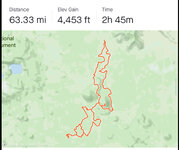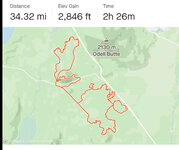I'm a 175lb B-rider here in New England. My 2018 MXR would go 27ish miles from full charge to light blinking when riding typical New England off-road trails - lots of rocks, roots, slow-ish speed stuff with a few quicker transition sections between. Even being a decent offroad rider, I found mode 3/4 unnecessary for the type of woods I ride, and even 2 wasn't really necessary. The type of riding here means the short little 20-30 second transition section you might actually use mode 3/4 power you're just recuperating from the last rough section and not really goosing it.
If the Stark bike could improve on that by about 5-ish miles, whether through battery capacity, motor efficiency or power modes, that would make a lot of sense to me because the 27-ish mile range I was getting was too short for a typical 2-hour NETRA hare scramble. I'm often at 25-30ish miles after 4-5 laps and 2 hours. Not being able to reliably hit 30 miles was a concern for me taking it racing. Not as big a deal when I was just playing around.
Aside from range, my bigger complaint for electric bike offroad riding wasn't actually the range - I thought it was reasonable given where battery tech is right now. I found the unmitigated, instant torque a real issue, especially when coupled with no clutch to modulate. I really do think that a clutch and/or "tuneable" or highly manageable traction control system would be a bigger turn on for me FOR OFFROAD USE IN CRAPPY, POOR TRACTION CONDITIONS - I didn't miss it anywhere else. The instant torque sure is a lot of fun in dry conditions, but as soon as it was at all muddy or even lightly wet, the bike really became a handful in rough rocky conditions. Forget about it when you're going up a big, rocky hill and the rear wheel gets stuck behind a big, slippery rock. So hard to find tractable power and actually get the bike moving. Major issue when actually racing...you'd waste a bunch of energy and pile up a big line of riders. I never ended up in a big mud pit where you can't get traction and your feet are sliding around with the Alta, but I imagine it would have been a disaster.
Doesn't the wheel spinning use a bunch of power too? The inclusion of better traction control or a clutch could actually improve range.



